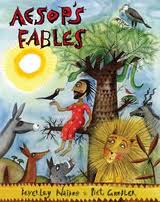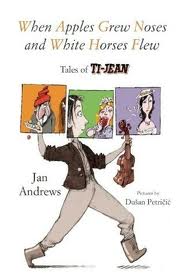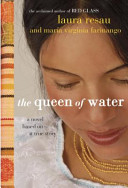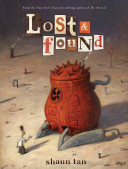When the Hag of Dribble, an orphan boy, and a troll called Ulf are sent to rescue a princess from an ogre, it turns out to be far from the routine magical mission they expect.
USBBY Outstanding International Book
Aftershock
Makis and his moher Sofia escape a devastating Greek earthquake which has claimed his father’s life. North London is a ver different place – but Makis quickly wins a covetted place in the school football team. Unlike her son, Sofia, isolated by her grief and lack of English, sinks into depression. Makis has a brilliant idea to help her – using books from school he begins to teach her to read. But competing loyalites mean that sooner or later, something has to give and his hard-won reputation at school appears to be in ruins.
Aesop’s Fables

A little mouse saves the life of a great lion; hungry Grasshopper, too lazy to store food, gets no mercy from the industrious ants; crafty Jackal tricks Klipspringer to escape death – but is himself tricked by the cock and the dog…. Here are 16 of Aesop’s wise, witty and timeless fables, portrayed for the first time in an African setting.
High Riders, Saints and Death Cars: A Life Saved by Art
Nicholas Herrera started life as a mischievous, dyslexic boy, born into one of the old Spanish families of New Mexico. Bad teachers and poor schooling helped him to lose himself in drugs, drinking, riding motorcycles and driving fast cars. A near-death experience, a wonderful mother and a fascination with making art saved him. Today Nicholas Herrera is one of the most noted Santeros in the US. His work is displayed in folk-art galleries across the country and is collected by the Smithsonian. He is noted for the highly personal, political nature of his work and his innovative treatment of what can sometimes be a rather bland art form designed to sell to tourists. His work is intensely personal and even confessional. A survivor of alcoholism and drug addiction, which almost led to his death in a terrible car crash, Herrera is now sober and remarkably productive. His art is his life and his life is his art. Extraordinarily charismatic, Herrera is the grandson, nephew and son of artists. His young daughter is now following in his footsteps.
When Apples Grew Noses and White Horses Flew

In these three imaginative stories, Jan Andrews introduces us to Quebec’s traditional folktale hero, Ti-Jean. He’s an endearing character who is both wise and foolish, and though he does find himself in hard situations (often of his own making), in the end, he somehow manages to do what needs to be done. In “Ti-Jean and the Princess of Tomboso” he eventually outwits a greedy princess; in “Ti-Jean the Marble Player” he gets the best of a pint-sized scoundrel; and in “How Ti-Jean Became a Fiddler” he turns the tables on a too-clever-for-her-own-good seigneur’s daughter, and finds true love in the process.
Migrant
Migrant farmers and their families represent an ever-growing body of laborers around the world. They are used as cheap labor but most of them are not allowed to settle down, integrate into their host countries and become citizens with full rights. This is, of course, devastating to their children.
Among these groups are the Mennonites from Mexico, who originally went to Mexico from Canada in the 1920s. They speak “Low German” and though many are poor, they are an important part of the Mexican farm community. Because of free trade and the fact that Mexican farmers cannot compete with highly subsidized US farmers, they have been forced to come back to Canada — as migrant workers — in order to survive. Anna is the child of Mennonites from Mexico, who have come north to harvest fruit and vegetables. Sometimes she feels like a bird, flying north in the spring and south in the fall, sometimes like a jackrabbit in an abandoned burrow, since her family occupies an empty farmhouse near the fields, sometimes like a kitten, as she shares a bed with her sisters. But above all Anna wonders what it would be like to be a tree rooted deeply in the earth, watching the seasons come and go, instead of being like a “feather in the wind.”
The Garden of Empress Cassia
Mimi lives with her parents above her father’s herbalist shop. She hates being Chinese and being teased at school. More than anything she loves to draw, so when her art teacher gives her a box of pastels Mimi is thrilled. These are no ordinary pastels for the inscription on the box warns that they are “A treasure for some, a curse for others”. Mimi is able to draw amazing scenes on the footpath outside her father’s shop and the pastels breathe life into the pictures for those able to see it. When Gemma, her tormentor at school, steals the pastels, Mimi knows she must get them back – not only to keep them safe and their magic intact, but to save Gemma from the pastel’s curse.
The Queen of Water

Born in an Andean village in Ecuador, Virginia lives with her large family in a small, earthen-walled dwelling. In her village of indígenas, it is not uncommon to work in the fields all day, even as a child, or to be called a longa tonta—stupid Indian—by members of the ruling class of mestizos, or Spanish descendants. When seven-year-old Virginia is taken from her village to be a servant to a mestizo couple, she has no idea what the future holds. In this poignant novel based on a true story, acclaimed author Laura Resau has collaborated with María Virginia Farinango to recount one girl’s unforgettable journey to self-discovery. Virginia’s story will speak to anyone who has ever struggled to find his or her place in the world. It will make you laugh and cry, and ultimately, it will fill you with hope.
Out of Shadows

A debut novel set in the early 1980s at a boy’s boarding school in the newly formed country of Zimbabwe.
Lost and Found

A collection of three jaw-dropping stories: THE RED TREE, THE LOST THING, and THE RABBITS, by New York Times bestselling author and illustrator Shaun Tan. A girl finds a bright spot in a dark world. A boy leads a strange, lost creature home. And a group of peaceful creatures loses their home to cruel invaders. Three stories about how we lose and find what matters most to us. Never widely available in the U.S., these tales are presented in their entirety with new artwork and author’s notes.
